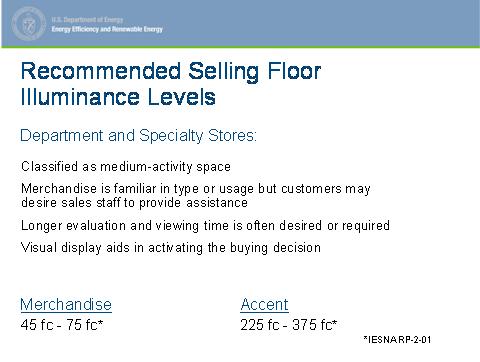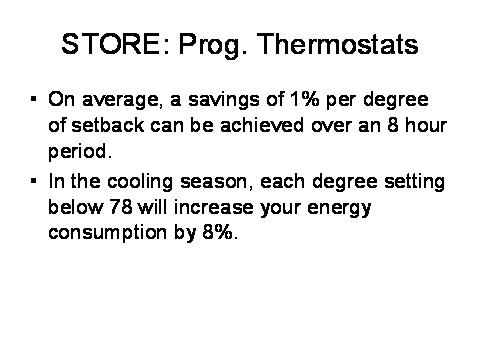Office and Retail facilities offer a broad range of energy efficiency opportunities. Both business types offer opportunity to improve performance in the area of lighting. Plug load reduction is particularly important in offices, and Operations and Maintenance, how the building is used and operated, and whether equipment is maintained are important for both business types.
PLUG LOADS – Management of plug loads has the potential to yield significant savings for the business owner or manager. Examples of equipment presenting plug loads are given below with examples of potential savings.
Computers: With power consumption that can top 100 watts, computer-related plug loads are among the largest electric draws in an office. Additional loads come from
servers, printers, scanners, speakers, and other peripherals. Computer power consumption can exceed 100 watts. Such a system left on 24/7 consumes nearly a million watts of energy per year. Using Energy Star certified equipment, and turning it off at night can easily reduce this by 50% or more.
A more detailed view: The average desktop computer consumes 75 watts in active mode, 4 watts in sleep mode, and 2 watts while turned off. A computer that’s turned off nights and weekends uses about 170 kWh per year on average, costing about $23 per year at $0.14/kWh. However, a typical desktop computer left on continuously will consume more than 650 kWh annually at a cost of almost $91.
Buy laptops: The best way to save energy on computers is to purchase laptop computers as you replace older machines. Laptop computers use 90% less energy than standard computers. The have the added benefit of being portable.
Monitors: In addition to the computer, a monitor requires a significant amount of energy even though LCD technology has produced some savings. Today’s flat panel LCDs draw substantially less power than cathode ray tube (CRT) monitors, which now account for less than 10 percent of new monitor sales. On average, a 15-inch LCD monitor consumes 20 watts while turned on, a 17-inch uses 31 watts, and a 19-inch model draws 35 watts. By comparison, a 17-inch CRT consumes 61 watts. Monitors of all types draw roughly 1 watt while in standby mode or when turned off.
Switch to LED monitors If you have a standard computer monitor, consider switching to a LED screen. They use 90% less energy and take up less space on your desk. The cost for these monitors has dropped significantly.
Servers: Among the fastest growing plug loads in the business sector. Although many companies have a dedicated server room or data center, few actively manage the energy consumption of these machines and the associated air-conditioning loads. One of the most effective ways to cut energy use is through virtualization, which allows you to consolidate multiple server functions into a single machine.
COPY MACHINES AND PRINTERS:
Make sure they are turned off at night and over weekends;
Turn copiers and printers off at night and on weekends. Even in the “sleep mode” these devices burn 30 to 40 watts of electricity. Instead of relying on the last one to leave the office turning it off, consider installing a low-cost plug-in 7-day timer that can be easily overridden to automatically shut off printers at night and on weekends. Contact the building manager if you would like to order 7-day timers.
Activate Power Management features;
For copy machines, refer to the User’s Manual or ask your service technician to determine if the Power Management features are enabled. The User’s Manual should provide the necessary instructions. Check the period of delay for activating energy-saver mode or automatic shut-off.
For printers, refer to the User’s manual or ask your service technician to check if your printer’s Power Management features are enabled. Start-up delays from recovery from sleep mode should be minimal.
Turn it off at night
Studies have shown that 30% of office workers leave their computers on at night. Turning off your computers and monitors every night can save $75.00 per year per computer. Don’t worry about the myth that turning a computer on and off will damage its chips. A computer will be obsolete long before there is damage to the equipment by cycling the power. If you have difficulty getting coworkers to cooperate, provide reminders such as putting up posters, including reminders in newsletters and sending group e-mails.
To automatically shut down your monitor and other office equipment when it is not needed, consider plugging your office equipment into an occupancy sensor power strip. These devices automatically turn off equipment whenever you leave the room for more than a few minutes. Occupancy power strips can control monitors, printers, fans, radios, and task lights. Contact the building manager to order occupancy power strips for your space.
Purchase Ink Jet Printers;
If it works for your business or work group, consider Ink Jet printers, which use 90% less energy than laser printers. In the San Francisco Bay Area, air conditioning accounts for 40% of a building’s energy use. There are a number of no-cost ways building occupants
Purchase Energy Star Equipment;
When purchasing new equipment, make sure it is Energy Star. Energy Star equipment comes with power management features enabled, though it may be disabled by the time it reaches your desk.
COMPUTERS:
Buy Energy Star;
Energy Star computers come with their power management features enabled.
Make sure energy saving features are activated;
Enabling a computer’s power management features enables the computer to power down to about 15% of its full power after a designated period of nonuse, usually 10 – 20 minutes. In older models, power management is set in a computer’s BIOS settings. These can be modified through the computer Setup at start-up. You can activate the power management feature by watching the black screen of a computer just before Windows starts up for instructions on how to Enter Setup mode. In Setup, navigate to “Power Management’ features and set to “enabled”. Use your arrow keys (down and right) to navigate. For a monitor and/or computer that has Energy Star features, adjustments are controlled through Control Panel/Display/Screen Saver. Set the “low power standby” to happen after 10 minutes and “shut off monitor’ after 30 minutes. It might be a good idea to have someone in your organization or IT department activate the energy management features for all the computers throughout your office.
Vending machines. Refrigerated vending machines typically operate 24 hours per day, seven days a week. In addition to consuming 2,500 to 4,400 kWh per year, they add to cooling loads in the spaces they occupy. At $0.09/kWh, annual operating costs typically range from $200 to $400. However, timers or occupancy sensors can yield significant savings because these technologies allow the machines to turn on only when a customer is present or when the compressor must run to maintain the product at the desired temperature. At least one device now on the market uses a passive infrared occupancy sensor to turn off the compressor and fluorescent lights in the vending machine when no one is around; a temperature sensor will power up the machine only as needed to keep products cool. Savings for vending machines equipped with these devices range from 24 to 76 percent, depending on usage patterns, occupancy in the area, and ambient conditions. When choosing new machines, select an Energy Star qualified model to ensure that it uses efficient compressors, fan motors, and lighting systems; Energy Star qualified vending machines are up to 50 percent more efficient than standard models.
LIGHTING:
Lighting typically consumes on the order of 40% of the energy used in an office building as shown above. Approaches to reducing lighting cost include:
Reduce ambient light levels and use task lighting;
Now that most reading and writing is performed on computers, light levels should be lower to eliminate glare and eyestrain. Consider leaving half the lights in private offices and partition areas off to reduce ambient light levels and installing an appropriate task light on desks for paperwork.
Turn unnecessary lights off;
Make sure the last person out of the office is instructed to turn off all of the lights. If you are working late, use task and individual office lights and turn off the remainder of the office lights.
In the lighting realm, using more low-wattage light-emitting diode (LED) desk lamps not only saves energy compared to incandescent bulbs, but if properly deployed, LED lamps may allow managers to delamp overhead fixtures for even greater savings.
AIR CONDITIONING:
Close the shades or blinds in the summer;
A major source of heat gain and cooling load for a building is the sun. In the summer, close your blinds or shades to keep the heat out during the hours the sun is on your side of the building.
Install programmable thermostats;
Check with the building engineer or manager regarding how the air conditioning is controlled for your office building. If the system operates more hours than is needed in your space, install a programmable thermostat. It will automatically turn off the system when the space is unoccupied.
In the summer, set the thermostat to 74 degrees;
For each degree you raise the cooling thermostat setting, up to 5% of cooling costs can be saved. Setting the thermostat at 74 instead of 68 degrees will save 30% on cooling costs.
SPACE HEATING:
In the winter, let the sun shine in;
The sun can help heat your office. Open your shades or curtains in the winter while the sun is shining.
In the winter, set the thermostat to 68 degrees;
For each degree you re reduce the heating thermostat setting, up to 5% of heating costs can be saved. Setting the thermostat at 68 instead of 72 degrees will save 20% on heating costs.
Don’t use space heaters;
Space heaters use a tremendous amount







